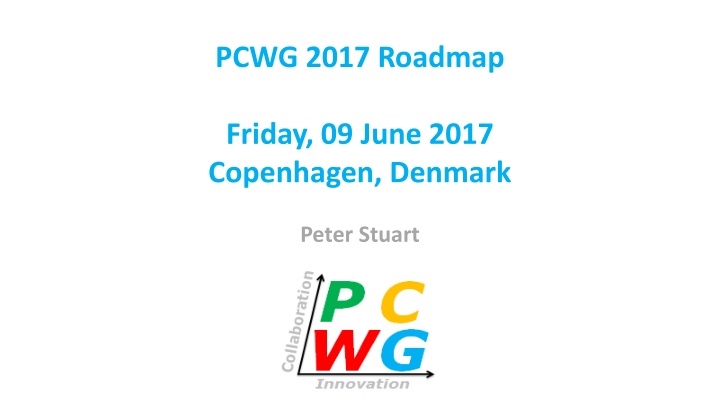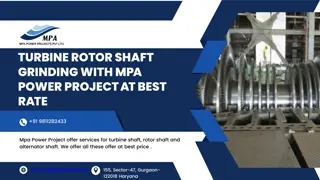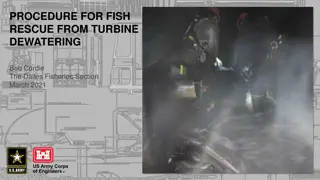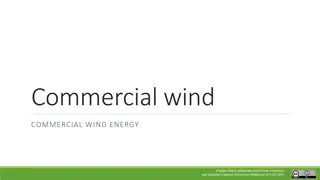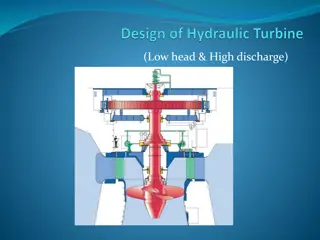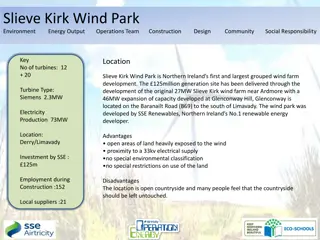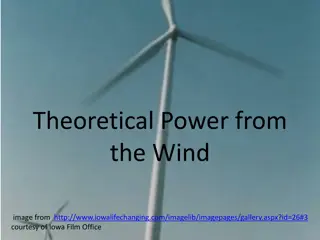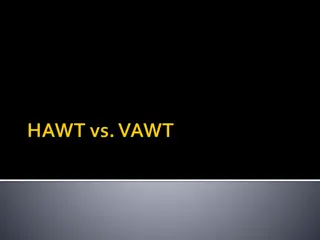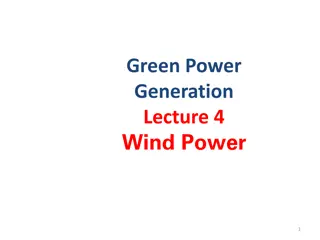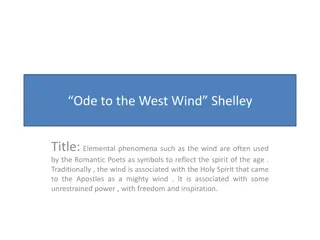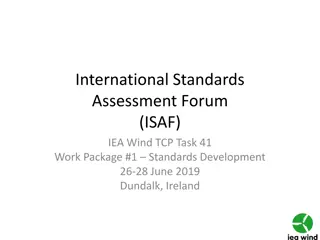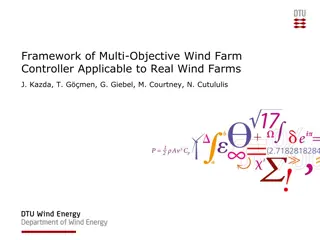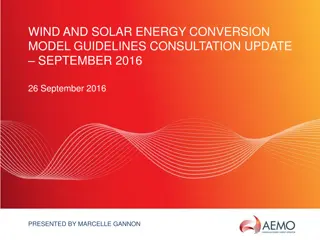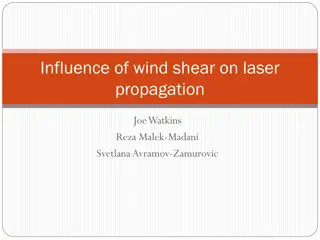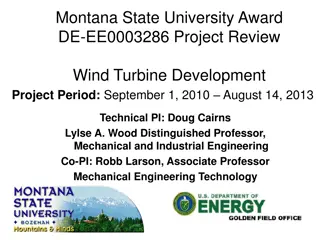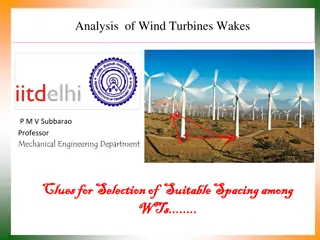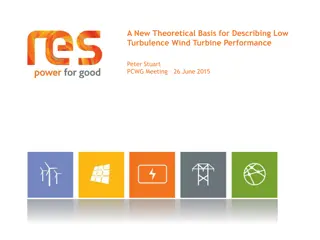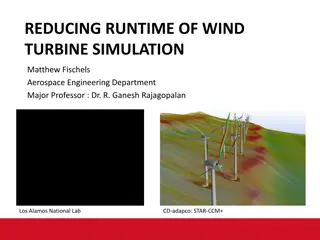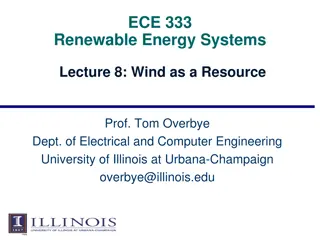Enhancing Wind Turbine Performance Through PCWG Activities
The PCWG (Performance Characterization Working Group) aims to improve real-world wind turbine performance prediction beyond the simple Power=P(v) equation. By introducing concepts like Inner-Outer Range Decomposition and Average-Specific Decomposition, the group addresses factors such as environmental conditions, blade degradation, and performance biases. Through intelligence sharing initiatives and performance adjustments, PCWG is working to refine turbine performance assessments and design processes for better future predictions.
Download Presentation

Please find below an Image/Link to download the presentation.
The content on the website is provided AS IS for your information and personal use only. It may not be sold, licensed, or shared on other websites without obtaining consent from the author.If you encounter any issues during the download, it is possible that the publisher has removed the file from their server.
You are allowed to download the files provided on this website for personal or commercial use, subject to the condition that they are used lawfully. All files are the property of their respective owners.
The content on the website is provided AS IS for your information and personal use only. It may not be sold, licensed, or shared on other websites without obtaining consent from the author.
E N D
Presentation Transcript
PCWG 2017 Roadmap Friday, 09 June 2017 Copenhagen, Denmark Peter Stuart
Weve Always Known that Real World Wind Turbine Performance is NOT as Simple as Power=P(v, )! Extract from C.J. Christensen et al: Accuracy of power curve measurements , Ris -M-2632, 1986... The power curve is then seen as the relation between the power P(v) produced by this undisturbed wind v. = Air Density P=P(v, ) Power (P) This definition is, however, of very doubtful value for a windmill in the natural wind. The main difficulty is that it assumes a smooth laminar flow of high degree of homogeneity and symmetry Wind Speed (v) The PCWG aims to build industry consensus on how best to predict real world turbine performance and look beyond P=P(v, ). www.pcwg.org.
Reflecting the Real World: Inner-Outer Range Decomposition Categories of Turbine Performance Corrections PCWG Activities Inner Range Performance Adjustments to reflect the fact that even under warranted/ideal conditions performance may not be 100% Outer Range Inner Range Outer Range Performance Adjustments to reflect the fact that turbine performance may deviate from Inner Range behaviour in Outer Range Conditions e.g. Low/High TI, Low/High Shear etc. Note: The PCWG Inner-Outer Range Proposal is Conceptual Decomposition, and does infer specific parameter ranges. + Other Performance Corrections Icing, Blade Degradation, Sub-optimal performance etc.
Reflecting the Real World: Average-Specific Decomposition Categories of Turbine Performance Corrections PCWG Activities Average Performance (Bulk) Adjustments to reflect the fact that on average (in all conditions) turbines may not meet their documented performance level Remove Bias Conditions Specific Performance Adjustments to reflect the fact that turbine performance may deviate from average performance in non-average Conditions e.g. Low/High TI, Low/High Shear etc. Remove Uncertainty Improve Project Design + Other Performance Corrections Icing, Blade Degradation, Sub-optimal performance etc.
Classification of PCWG Activities by Component Note: whilst the two decompositions are subtly different, they are broadly compatible with respect to the roadmap e.g. actions to further Inner Range understanding, will generally further Average Performance understanding. The type of PCWG activates differs strongly depending on the problem component The PCWG is seeking to define an assessment framework to define how to make best use of historic power performance tests when predicting future inner/average performance. Inner Range Performance Average Performance The PCWG is attempting to evaluate quantitative methods for predicting Outer/ Specific performance Intelligence Sharing Initiative (PCWG-Share-X) Outer Range Performance via the PCWG Conditions Specific Performance
Reflecting the Real World: Inner Range / Average Performance Extract from High Resolution Turbine-Specific Matrix , Carl Ostridge DNV GL, Colorado PCWG Meeting, 10 August 2016, download from www.pcwg.org.
Reflecting the Real World: Outer Range Performance Outer Range Deviations (Observed Base) Inner Range Performance Turbulence Intensity [%] Colour = % Observed Power Deviation (Observed - Base) High TI & High V Negative Deviation Low TI & Low V Negative Deviation Power (P) High TI & Low V Positive Deviation P=P(v, ) Wind Speed (v) Wind Speed [m/s]
PCWG 2017 Roadmap Roadmap Page 1/4 OUTCOME 1. Inner/Average Performance Evidence Pathway for Inner/Average Performance Reduced Investor Risk Define best practice guidelines for stakeholder data exchange and analysis to establish inner/average performance 2. Outer/Specific Performance 50% reduction in outer/specific modelling uncertainty Reduced Investor Risk Objectively determine/refine the best methods for modelling outer/specific performance using the PCWG-Share-X Platform 3. Enabling Activities The right tools & industry understanding to deliver items 1 & 2 Publically available worked Examples PCWG Analysis Tool Development End of 2017 NOW
PCWG 2017 Roadmap Roadmap Page 4/4 1. Inner/Average Performance Define best practice guidelines for stakeholder data exchange and analysis to establish inner/average performance 2017 - Timeline Draft Guidelines Document (based on a overhaul of existing DRAFT guidelines for preparation of a turbine information pack document). Aug Feedback Sep Updated Draft Document Oct Final Feedback Nov Dec Publication on PCWG Website
Roadmap Page 3/4 2. Outer/Specific Performance 2017 - Timeline PCWG-Share-2 June Aug PCWG-Share-3 PCWG-Share-4 Oct
PCWG 2017 Roadmap Roadmap Page 4/4 3. Enabling Activities Publically Available Worked Examples IEC Worked Examples Non-IEC Worked Examples e.g. Production by Height, Marmander Interpolation etc. PCWG Analysis Tool Development Implementation of New Methods Improved Testing and worked examples Improved Beta Testing (Beta Testing Sub Group) Improved Documentation (Beta Testing Sub Group) Machine Learning Sub-group meetings and discussions Creation of Machine Learning Web Service for PCWG-Share-4 Publish Summary of PCWG Activities & Outcomes (on PCWG Website)
